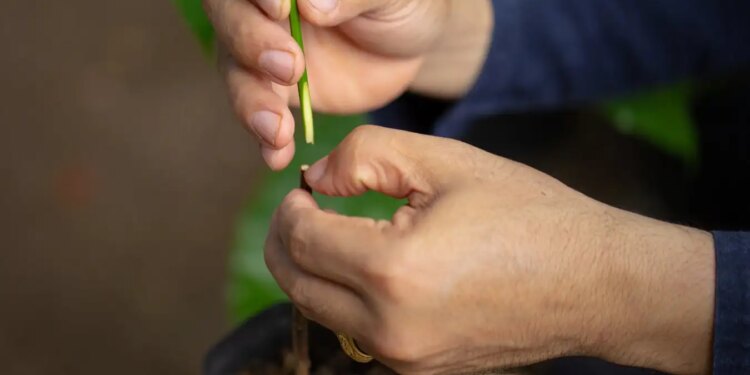
Coffee plants can be propagated by grafting a shoot onto the rootstock of another plant
sirichai_asawalapsakul/Getty Images
The ancient trick of grafting one plant onto another could find a very modern use – enabling gene editing of plants that are very difficult or impossible to edit by other means.
“It is still at the beginning stage, but this technique has great potential,” says Ugo Rogo at the University of Pisa in Italy.
Making plants more productive and more nutritious is vital for tackling the huge damage done by farming and for limiting food price hikes as the world’s population grows and climate change increasingly hits yields. The precise changes that can be made with CRISPR gene editing are the best way of achieving this.
However, gene editing plants is tricky because plants have rigid cells walls around them, unlike animal cells. Conventional genetic engineering of plants involves techniques such as firing DNA-impregnated pellets at plant cells – known as biolistics – or using a natural gene-engineering microbe known as Agrobacterium.
These approaches rely on generating entire plants from modified cells, and with many plants, especially trees, this cannot be done. For instance, it does not work with cocoa, coffee, sunflowers, cassava or avocados.
Even for plants where it does work, there is another major issue. When gene editing is used to induce tiny mutations of the kind that are very common naturally, regulators in several countries see it as equivalent to standard plant breeding, meaning such plants can get approval without the long and expensive trials required for conventional genetically-modified plants. But with biolistics and Agrobacterium, extra DNA is often inserted into plants’ genomes, so they would have to go through the full regulatory process.
Plant scientists are trying to find ways of editing plants that work for more species and that don’t add any unwanted bits of DNA to the genome. One option is to use viruses to deliver RNA coding for parts of the CRISPR toolkit to plant cells. Here, the problem is the Cas9 protein widely used for gene editing is very large, meaning the RNA coding for it can’t fit into most viruses.
In 2023, Friedrich Kragler at the Max Planck Institute of Molecular Plant Physiology in Germany unveiled another approach. He knew plant roots produce a special type of RNA that can travel around plants and enter cells in the shoots and leaves.
So his team genetically engineered plants to produce such RNAs coding for two key CRISPR components: the Cas protein that does the editing and the guide RNA that tells it where to make the edit. They then grafted shoots of non-modified plants onto the roots of the modified plants, and showed this resulted in gene editing of some of the shoots and seeds.
Rogo and his colleagues think the approach is so promising they have now written a paper highlighting it and encouraging others to help develop it. “Grafting gives us the possibility to use the CRISPR system in trees or in plants such as sunflowers,” Rogo says.
The key thing about grafting is relatively distantly related plants can be grafted onto each other – for instance, you can graft tomato shoots onto potato rootstocks. So even though it isn’t possible to genetically engineer a sunflower rootstock for gene editing, it should be possible to engineer related plants to make a compatible rootstock.
Once there is a rootstock producing the necessary RNAs, it can be used to gene edit a wide variety of plants. “You can use the roots to deliver Cas9 and editing guides to all sorts of elite varieties,” says Julian Hibberd at the University of Cambridge.
“Making the transgenic rootstock is not a big effort, given that it just needs to be made once, and then can be used forever and for multiple species,” says Ralph Bock, who is also at the Max Planck Institute but not part of Kragler’s team.
As one example, only a few grape varieties, such as Chardonnay, can regenerate from single cells and can thus be modified. But once a Chardonnay gene editing rootstock conferring, say, disease resistance has been created, it would work for all grape varieties and beyond.
Rogo also envisages combining grafting with the viral approach. Rootstocks could be used to deliver the large mRNAs for Cas9, while viruses provide the guide RNAs. In this way, the same rootstock could be used to make many different gene edits, he says.
Topics:
Source link : https://www.newscientist.com/article/2502509-grafting-trick-could-let-us-gene-edit-a-huge-variety-of-plants/?utm_campaign=RSS%7CNSNS&utm_source=NSNS&utm_medium=RSS&utm_content=home
Author :
Publish date : 2025-11-06 09:00:00
Copyright for syndicated content belongs to the linked Source.














